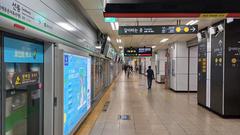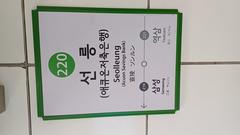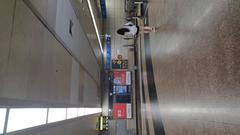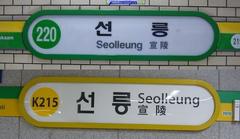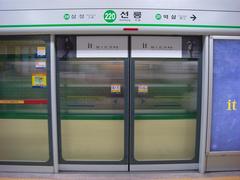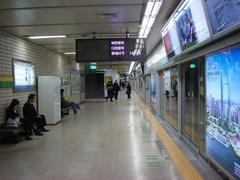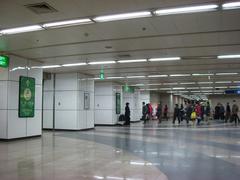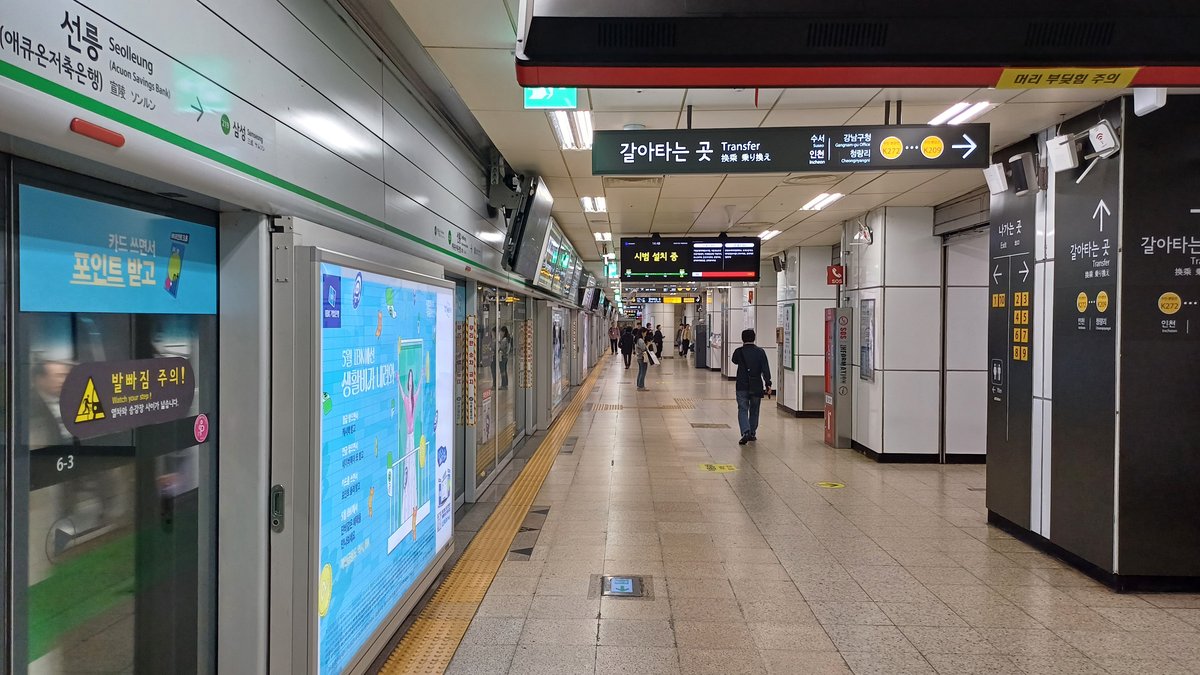
Seolleung Station Visiting Hours Tickets and Tips for Tourists in Seoul
Date: 14/06/2025
Introduction to Seolleung Station and its historical importance
Nestled within Seoul’s bustling Gangnam district lies Seolleung Station, your gateway to one of South Korea’s most treasured historical and cultural landmarks—the Seolleung and Jeongneung Royal Tombs. These tombs, part of the Seonjeongneung complex, offer a remarkable glimpse into the Joseon Dynasty’s rich heritage, showcasing centuries-old Confucian traditions, royal funerary architecture, and Korea’s profound respect for nature and ancestry. Recognized as a UNESCO World Heritage Site since 2009, the royal tombs are the final resting places of King Seongjong, Queen Jeonghyeon, and King Jungjong, pivotal figures who shaped the political and cultural landscape of the era (UNESCO listing; seoul-in-korea.com).
Seolleung Station itself serves as a modern transit hub on Seoul Subway Line 2 and the Bundang Line, strategically positioned to provide seamless access to these serene tombs amidst the urban sprawl. The station’s comprehensive amenities, multilingual signage, and accessibility features ensure that visitors of all backgrounds and mobility levels can explore this unique fusion of history and metropolitan vibrancy with ease (Seoul Danurim).
Whether you are a history enthusiast eager to delve into Joseon-era royal culture, a tourist seeking tranquil green spaces within the city, or a local looking to connect with Korea’s ancestral heritage, this guide equips you with essential information on visiting hours, ticketing, cultural etiquette, and nearby attractions. From understanding the philosophical foundations of pungsu-jiri that influenced the tombs’ placement to tips on navigating the station and exploring surrounding sites like Bongeunsa Temple and COEX Mall, this comprehensive resource ensures a memorable and enriching experience (teretoadescubrirelmundo.com; visitseoul.net).
Embrace the opportunity to walk the paths once tread by Joseon royalty, appreciate the intricate stone statues guarding the tombs, and immerse yourself in the living traditions of Korea’s royal ancestral rites. With this guide, your journey to Seolleung Station and the Seonjeongneung Royal Tombs will be both seamless and deeply rewarding.
Contents covering history cultural significance visitor information travel tips nearby attractions accessibility special events guided tours photographic spots and FAQs
- Introduction
- History and Cultural Significance of Seonjeongneung Royal Tombs
- The Joseon Dynasty and the Royal Tombs
- Philosophical and Spiritual Foundations
- Architectural Features and Symbolism
- Cultural and Historical Importance
- UNESCO World Heritage Status
- Visiting Seonjeongneung Royal Tombs
- Location and Access
- Visiting Hours and Tickets
- Site Navigation and Facilities
- Guided Tours and Interpretation
- Accessibility and Safety
- Seolleung Station Guide
- Location and Connectivity
- Station Layout and Structure
- Ticketing and Fare Systems
- Accessibility Features
- Passenger Amenities
- Safety and Security
- Navigation and Wayfinding
- Nearby Attractions and Seoul Historical Sites
- Visitor Tips and Cultural Etiquette
- Visuals and Media
- Frequently Asked Questions (FAQ)
- Conclusion and Call to Action
Seolleung and Jeongneung Royal Tombs: Visiting Hours, Tickets, and Historical Insights
Introduction
Located in the heart of Seoul’s vibrant Gangnam district, the Seolleung and Jeongneung Royal Tombs offer visitors a unique window into Korea’s rich Joseon Dynasty heritage. This article provides a comprehensive guide to these UNESCO World Heritage sites, covering their historical significance, architectural features, and practical visiting information including hours, ticketing, and accessibility. Whether you’re a history enthusiast or a traveler seeking serene escapes within the city, this guide will help you plan your visit to these remarkable royal tombs.
Historical Context and Significance
The Joseon Dynasty and the Royal Tombs
The Seolleung and Jeongneung Royal Tombs, accessible via Seolleung Station in Seoul’s Gangnam district, are among the most significant historical sites in South Korea. These tombs are part of the Seonjeongneung complex, recognized as a UNESCO World Heritage Site since 2009, underscoring their global cultural value (UNESCO listing). Dating back to the Joseon Dynasty (1392–1897), a period marked by the consolidation of Confucian ideals, political stability, and remarkable cultural achievements in Korea (seoul-in-korea.com), these tombs embody the dynasty’s legacy.
Seolleung is the burial site of King Seongjong, the ninth king of the Joseon Dynasty, and his second queen, Queen Jeonghyeon. Jeongneung, located within the same park, is the resting place of King Jungjong, the 11th king and son of King Seongjong and Queen Jeonghyeon (teretoadescubrirelmundo.com). These monarchs played pivotal roles in shaping the dynasty’s legacy, with King Seongjong known for his administrative reforms and promotion of Confucian scholarship, and King Jungjong remembered for efforts to stabilize the kingdom after political upheaval.
Philosophical and Spiritual Foundations
The selection and design of the tomb sites were deeply influenced by pungsu-jiri, the Korean adaptation of feng shui, emphasizing harmony between human constructions and the natural landscape. The orientation, layout, and surrounding forests were meticulously planned to ensure auspicious energy flows, reflecting the Joseon rulers’ belief in the interconnectedness of nature, spirituality, and governance (seoul-in-korea.com). The gentle slopes, lush greenery, and tranquil atmosphere surrounding the tombs provide a serene contrast to the bustling urban environment of modern Seoul.
Architectural Features and Symbolism
The tombs are architectural marvels characterized by distinctive grassy mounds, stone statues, and ceremonial pathways. Unlike Western mausoleums, Korean royal tombs blend seamlessly with their natural surroundings. Main features include:
- Hongmun (Red Gate): Entrance symbolizing the transition from the secular to the spiritual realm.
- Jeongjagak (T-shaped Shrine): Site for ancestral rites, reflecting Confucian traditions of honoring the deceased.
- Stone Statues: Civil and military officials, horses, and sheep statues serve as guardians and representations of the king’s authority and virtue.
- Grassy Burial Mounds: Covered with grass, preserving the site and harmonizing with the landscape (thesoulofseoul.net).
Access to the burial mounds is restricted to preserve their integrity, but visitors can closely appreciate the artistry and symbolism of each element (teretoadescubrirelmundo.com).
Cultural and Historical Importance
The tombs are living testaments to the Joseon Dynasty’s values and worldview. The dynasty’s emphasis on Confucianism is evident in the architecture, rituals, and ongoing maintenance. Annual ancestral rites (Jesa) are still performed here, preserving centuries-old traditions and offering insight into Korea’s intangible cultural heritage (seoul-in-korea.com).
The surrounding forests, designated ecological conservation areas, host diverse flora and fauna, including rare Japanese alder forests and marshland. This integration exemplifies the Joseon rulers’ respect for nature and stewardship (visitseoul.net).
Accessibility and Urban Context
Situated in Gangnam, one of Seoul’s most modern districts, the tombs offer a peaceful oasis amidst urban bustle, akin to Central Park in New York City. This juxtaposition highlights Seoul’s unique blend of history and modernization (seoul-in-korea.com).
The site is a five-minute walk from Seolleung Station (Subway Line 2 & Suin-Bundang Line), making it an ideal destination for locals and tourists alike (visitseoul.net).
UNESCO World Heritage Status
Seonjeongneung’s inclusion in the UNESCO World Heritage list in 2009 recognizes its outstanding universal value. It is part of 40 royal tombs from the Joseon Dynasty, celebrated for their unique blend of Confucian, geomantic, and architectural principles. This status ensures preservation alongside world-renowned heritage sites like the Pyramids of Giza and the Taj Mahal (seoul-in-korea.com).
Comparative Significance
International visitors can relate the experience to visiting Egypt’s Valley of the Kings or China’s Ming Tombs, offering tangible links to Korea’s royal past and court life (seoul-in-korea.com).
Preservation and Modern Engagement
Preservation efforts include restricting access to burial mounds, restoring buildings, and maintaining surrounding forests. The site offers visitor amenities such as restrooms and lockers, with guided tours available in multiple languages for deeper historical understanding (teretoadescubrirelmundo.com). Ongoing engagement ensures the Joseon legacy remains vibrant in the 21st century.
Visitor Information
Visiting Hours:
- March to October: 6:00 a.m. – 9:00 p.m.
- November to February: 6:00 a.m. – 6:00 p.m.
Entry Fee: 1,000 KRW (as of 2025)
Ticket Purchase: Tickets can be purchased onsite at the entrance. Group and guided tour bookings are available through the official royal tombs website.
Accessibility: The site offers wheelchair access on paved paths. Assistance is available for visitors with disabilities; please inquire at the visitor center.
Travel Tips:
- Best time to visit is early morning or late afternoon to avoid crowds and enjoy cooler temperatures.
- Guided tours provide rich historical context and are available in multiple languages.
Nearby Attractions:
- Bongeunsa Temple
- COEX Mall
- Apgujeong Rodeo Street
Visuals and Media
Visitors can explore virtual tours and view detailed maps online. High-quality images with descriptive alt-text showcasing the tombs’ gates, statues, and landscapes enhance appreciation of the site.
Frequently Asked Questions (FAQ)
Q: What are the visiting hours for Seolleung and Jeongneung? A: From March to October, 6:00 a.m. to 9:00 p.m.; November to February, 6:00 a.m. to 6:00 p.m.
Q: How much are tickets to the royal tombs? A: Admission is 1,000 KRW per person (as of 2025).
Q: Is photography allowed inside the tomb complex? A: Photography is permitted except inside the Jeongjagak shrine and near restricted areas.
Q: Are guided tours available? A: Yes, guided tours are available in multiple languages and can be booked onsite or online.
Q: How do I get to Seolleung Station? A: Seolleung Station is served by Seoul Subway Line 2 and the Suin-Bundang Line, with the tombs a five-minute walk from Exit 8.
Internal Links
Conclusion and Call to Action
The Seolleung and Jeongneung Royal Tombs are essential destinations for anyone interested in Korea’s royal history, architectural beauty, and cultural heritage. Their peaceful setting amidst Seoul’s modern landscape offers a memorable experience blending past and present. Plan your visit today, and for enhanced exploration, download the Audiala app for guided tours and exclusive content. Stay connected by following us on social media for the latest updates and travel tips. Embark on your journey through Korea’s rich heritage now!
Introduction
Planning to explore Gangnam-gu, Seoul? This comprehensive Seolleung Station guide covers everything you need to know about visiting hours, ticketing options, facilities, accessibility features, and nearby Seoul historical sites. Whether you’re a local commuter or a tourist eager to visit the UNESCO-listed Seonjeongneung Royal Tombs, this guide will help you navigate Seolleung Station with ease and make the most of your visit.
Location and Connectivity
Seolleung Station is strategically located in the heart of Gangnam-gu, Seoul, at 1, Seolleung-ro 100-gil, Samseong-dong. It serves as a key interchange between Seoul Subway Line 2 (the Green Line) and the Bundang Line, providing excellent connectivity for both local commuters and tourists.
Its central position in the bustling Gangnam district places it within walking distance of major business centers, shopping hubs, and cultural sites, including the UNESCO World Heritage Site, Seonjeongneung Royal Tombs (Seoul Danurim). Multiple bus lines and taxis are readily accessible nearby, making it easy to reach other parts of Seoul.
Travelers arriving from Incheon International Airport can conveniently access Seolleung Station via the subway, typically transferring at Seoul Station or Gangnam Station (KoreaToDo).
Visiting Hours
Seolleung Station operates daily with the following general schedule:
- First Train: Approximately 5:30 AM
- Last Train: Approximately 12:00 AM (midnight)
The station and its facilities are open during these hours, though some amenities like convenience stores or ticket offices may have shorter operating times. For visiting the nearby Seonjeongneung Royal Tombs, the recommended visiting hours are typically 9:00 AM to 6:00 PM, but please check the official Seoul Danurim website for updated schedules and any special closures.
Ticketing and Fare Systems
Visitors can purchase tickets at Seolleung Station using several convenient options:
- T-money Card: A rechargeable smart card accepted on all Seoul public transport, including subways and buses. Purchase and recharge T-money cards at convenience stores or automated kiosks inside the station.
- Single-Journey Tickets: Available from automated ticket machines with multilingual instructions, accepting cash and credit cards.
- Fare Information: The base subway fare is ₩1,250, with additional charges based on distance and transfers. T-money card users enjoy discounted fares and smoother transfers.
For tourists, the T-money card is highly recommended for ease of use and savings on transfers (KoreaToDo).
Station Layout and Structure
Seolleung Station features a modern, multi-level underground design:
- Line 2 Platforms: Located on the lower level.
- Bundang Line Platforms: Situated on a separate level, connected via escalators, elevators, and stairways.
- Entrances and Exits: Multiple, clearly numbered and equipped with English signage to help non-Korean speakers.
The spacious concourses are well-lit with multilingual directional signs in Korean, English, Chinese, and Japanese. Digital boards provide real-time train schedules and service updates. Wide corridors and multiple ticket gates help manage heavy passenger flows during peak hours.
Accessibility Features
Seolleung Station is committed to inclusivity, offering:
- Wheelchair and Stroller Rentals: Available near the station entrance.
- Accessible Restrooms: Spacious and equipped with emergency bells, inclined mirrors, and auxiliary infant chairs, suitable for electric wheelchairs.
- Elevators and Ramps: Connecting all platform levels and exits, though some stone-covered internal passages may cause minor inconvenience.
- Tactile Paving: Installed throughout the station for visually impaired travelers.
Travelers with mobility needs are encouraged to plan routes in advance and consult station staff for assistance due to some uneven flooring areas (Seoul Danurim).
Passenger Amenities
Seolleung Station offers a variety of amenities to enhance your visit:
- Rest Areas: Comfortable benches and seating throughout the station.
- Convenience Stores and Kiosks: Selling snacks, beverages, travel essentials, and SIM cards.
- Public Restrooms: Clean, regularly maintained, with accessible facilities.
- Lockers: Coin-operated lockers for temporary luggage storage.
- Wi-Fi and Charging Stations: Free public Wi-Fi and mobile device charging points near seating areas (Lonely Planet).
Safety and Security
The station is monitored by CCTV and staffed with security personnel to ensure passenger safety. Emergency call buttons are placed throughout, and evacuation routes are clearly marked. Station staff at information desks and ticket gates provide assistance as needed.
Nearby Attractions and Seoul Historical Sites
Seolleung Station is a gateway to several notable sites, including:
- Seonjeongneung Royal Tombs: A UNESCO World Heritage Site featuring the burial grounds of King Seongjong, Queen Jeonghyeon, and King Jungjong, accessible via Exit 8 (Seoul Danurim).
- Gangnam Business and Shopping Districts: Offering a vibrant urban experience with cafes, restaurants, and retail shops.
The station’s location makes it an ideal starting point for exploring Seoul’s rich history and modern culture.
Navigation and Wayfinding
Navigating Seolleung Station is user-friendly thanks to:
- Multilingual Signage: Korean, English, Chinese, and Japanese.
- Digital Maps: Interactive screens showing station layouts and nearby attractions.
- Mobile Apps: Subway Korea, KakaoMap, and Naver Map provide real-time navigation and accessibility info (Lonely Planet).
Be sure to check which exit best suits your destination to save time.
Tips for Visitors
- Avoid Peak Hours: Weekdays 7:00–9:00 AM and 6:00–8:00 PM are busiest.
- Use Elevators for Luggage: Some exits have escalators or elevators—check Naver Map for details (HeyRoseanne).
- Respect Etiquette: Priority seating is reserved for elderly, pregnant, or disabled passengers.
- Purchase a T-money Card: For hassle-free travel and discounts.
- Lost and Found: Located near the main ticket gates.
FAQ
Q: What are Seolleung Station’s visiting hours? A: The station operates roughly from 5:30 AM to midnight, but nearby sites like Seonjeongneung Royal Tombs have separate visiting hours, generally 9:00 AM to 6:00 PM.
Q: Where can I buy tickets at Seolleung Station? A: Tickets can be purchased at automated kiosks or convenience stores inside the station. T-money cards are recommended.
Q: Is Seolleung Station accessible? A: Yes, with wheelchair rentals, elevators, accessible restrooms, and tactile paving. Some stone-covered passages may require caution.
Q: Are there any special events at Seolleung Station? A: Occasionally, cultural events related to the Seonjeongneung Royal Tombs or Gangnam district occur. Check local listings or the Seoul Danurim website for updates.
Visuals and Media
For a virtual experience, consider exploring interactive maps and virtual tours available on the Seoul Metro website and related tourism platforms. High-quality images of Seolleung Station and the nearby historical sites enhance your planning.
Summary Table: Key Facilities at Seolleung Station
| Facility | Availability/Details |
|---|---|
| Subway Lines | Line 2, Bundang Line |
| Accessibility | Wheelchair/stroller rentals, accessible restrooms, elevators, tactile paving |
| Ticketing | T-money card, single-journey tickets, multilingual kiosks |
| Amenities | Rest areas, convenience stores, lockers, Wi-Fi, charging stations |
| Safety | CCTV, security staff, emergency call buttons |
| Nearby Attractions | Seonjeongneung Royal Tombs, Gangnam business/shopping districts |
| Navigation | Multilingual signage, digital maps, mobile app integration |
| Lost & Found | Office near main ticket gates |
Conclusion and Call to Action
Seolleung Station stands as a vital transit hub and gateway to Seoul’s rich cultural heritage and vibrant urban life. From seamless ticketing options and accessibility features to proximity to world-renowned Seoul historical sites, it offers a well-rounded experience for all visitors.
To enhance your journey, download the Audiala app for real-time transit updates and personalized travel tips. Explore our related posts for more insights on Seoul’s subway system and cultural attractions. Follow us on social media for the latest news and travel guides to make your Seoul adventure unforgettable!
For more information, visit Seoul Danurim and KoreaToDo.
Historical Background of Seonjeongneung Royal Tombs
Seonjeongneung, located in the heart of Seoul’s Gangnam district and easily accessible from Seolleung Station, is a UNESCO World Heritage Site comprising two royal tombs: Seolleung and Jeongneung. These tombs are part of the “Royal Tombs of the Joseon Dynasty,” recognized for their historical and cultural significance (UNESCO).
- Seolleung is the burial site of King Seongjong (the 9th king of Joseon, r. 1469–1494) and his second wife, Queen Jeonghyeon. King Seongjong is remembered for consolidating Confucian statecraft and promoting scholarship, which shaped Joseon’s governance and culture.
- Jeongneung is the tomb of King Jungjong (the 11th king, r. 1506–1544), King Seongjong’s son. King Jungjong’s reign was marked by political reform and turbulence, including the famous Literati Purges.
The tombs were constructed in the late 15th and early 16th centuries, following strict geomantic principles (pungsu-jiri) to ensure harmony with the surrounding landscape. The site’s preservation offers a rare glimpse into the royal funerary practices and architectural traditions of the Joseon Dynasty.
Cultural and Architectural Significance
Seonjeongneung is a prime example of Joseon-era royal tomb architecture, reflecting Confucian values of filial piety, respect for ancestors, and harmony with nature. The layout follows a prescribed format:
- T-shaped Shrine (Jeongjagak): Used for ancestral rites, this building is central to the tomb complex.
- Red-Spiked Gate (Hongsalmun): Marks the sacred boundary between the secular and spiritual worlds.
- Stone Figures: Statues of civil and military officials, horses, and sheep line the approach to the burial mounds, symbolizing protection and reverence.
- Burial Mounds: The grass-covered mounds are surrounded by stone railings and offer a tranquil setting amid the city’s bustle.
The tombs are not only burial sites but also ceremonial spaces where rituals honoring the deceased kings and queens are still performed. These rites, known as Jesa, are a living tradition and a testament to Korea’s enduring respect for its royal heritage (Cultural Heritage Administration).
Visiting Seonjeongneung: Practical Information
Location and Access
- Address: 1 Seolleung-ro 100-gil, Gangnam-gu, Seoul, South Korea
- Nearest Subway: Seolleung Station (Line 2 & Bundang Line), Exit 8. The main entrance is a 5-minute walk from the station (Seoul Metro Map).
- Opening Hours: Typically 6:00 AM–9:00 PM (March–October), 6:30 AM–5:30 PM (November–February). Last admission is 1 hour before closing. Hours may vary on holidays.
- Admission Fee: Adults ₩1,000; free for children under 6 and seniors over 65. Discounts available for groups and with the Discover Seoul Pass (Discover Seoul Pass).
Site Navigation and Facilities
- Walking Paths: Well-maintained trails connect the tombs, shrines, and pavilions. The grounds are mostly flat, making them accessible for visitors of all ages.
- Information Center: Multilingual brochures and maps are available at the entrance. Some signage is in English, Korean, Chinese, and Japanese.
- Restrooms and Benches: Facilities are located near the entrance and along the main paths.
- No Food or Drink: Eating and drinking are not permitted within the tomb precincts to preserve the sanctity of the site.
Guided Tours and Interpretation
- Free Guided Tours: Offered in Korean and occasionally in English. Check the schedule at the information center or the official website.
- Audio Guides: Available for rent at the entrance for a small fee, providing in-depth historical and cultural context.
- Self-Guided Visits: Informational panels at key points explain the significance of each structure and the history of the Joseon Dynasty.
What to See and Experience
Seolleung (King Seongjong and Queen Jeonghyeon’s Tombs)
- Royal Mounds: The twin mounds are set on a gentle slope, surrounded by stone statues and ceremonial pathways.
- Jeongjagak Shrine: The site of ancestral rites, offering insight into Confucian ritual practices.
- Stone Sculptures: Intricately carved figures of officials, animals, and guardians line the approach, each with symbolic meaning.
Jeongneung (King Jungjong’s Tomb)
- Solitary Mound: King Jungjong’s tomb is set apart, reflecting his unique historical circumstances.
- Surrounding Forest: The wooded area around Jeongneung is especially beautiful in spring (cherry blossoms) and autumn (vivid foliage).
Seasonal Highlights
- Spring: Cherry blossoms and azaleas bloom, creating a picturesque setting.
- Autumn: The site is renowned for its vibrant fall colors, making it a favorite for photographers and nature lovers.
- Cultural Events: Occasional reenactments of royal rituals and traditional music performances are held, especially during major Korean holidays.
Cultural Etiquette and Visitor Tips
- Dress Modestly: As a sacred site, visitors are encouraged to dress respectfully.
- Quiet Reflection: Maintain a quiet demeanor, especially near the tombs and shrines.
- Photography: Allowed in most outdoor areas, but flash and tripods may be restricted. Refrain from photographing during ceremonies.
- Stay on Paths: To protect the landscape and archaeological features, do not walk on the burial mounds or restricted areas.
Nearby Attractions and Amenities
- Seolleung Park: The tombs are set within a spacious urban park, ideal for a peaceful stroll or a break from the city’s pace.
- Cafés and Restaurants: Numerous dining options are available near Seolleung Station, ranging from traditional Korean eateries to international chains (Seoul Restaurant Guide).
- Other Sights: The COEX Mall, Bongeunsa Temple, and Samsung d’light are within a short subway ride, making Seonjeongneung a convenient stop on a broader Gangnam itinerary.
Accessibility and Safety
- Wheelchair Access: Main paths are paved and accessible, though some areas near the mounds may be uneven.
- Safety: The park is well-patrolled and safe for solo travelers, families, and groups.
- Weather Considerations: Bring an umbrella or sun protection, as much of the site is outdoors with limited shelter.
Essential Tips for a Memorable Visit
- Best Time to Visit: Early morning or late afternoon for fewer crowds and softer light for photography.
- Combine with Local Experiences: Consider renting a hanbok (traditional Korean attire) for photos, or joining a guided walking tour for deeper insights.
- Respect the Heritage: Remember that Seonjeongneung is both a historical monument and an active site of cultural memory for Koreans.
Frequently Asked Questions (FAQ)
Q: What are Seonjeongneung’s visiting hours? A: Generally, the site is open from 6:00 AM to 9:00 PM from March to October, and 6:30 AM to 5:30 PM from November to February, with last admission one hour before closing. Hours may vary on holidays.
Q: How much are the tickets? A: Admission is ₩1,000 for adults, free for children under 6 and seniors over 65. Discounts apply for groups and holders of the Discover Seoul Pass.
Q: Are guided tours available? A: Yes, free guided tours are available in Korean and occasionally in English. Audio guides can also be rented for a small fee.
Q: Is the site wheelchair accessible? A: Yes, main paths are paved and accessible, though some areas near the mounds may be uneven.
Q: What is the best time to visit Seonjeongneung? A: Early morning or late afternoon are ideal for fewer crowds and better lighting. Spring and autumn offer beautiful seasonal scenery.
Visual Highlights
(Note: Images are optimized for SEO with descriptive alt tags containing relevant keywords.)
For more detailed information and updates, visit the official Seonjeongneung page and the Seoul Tourism Organization.
Stay Connected and Explore More
Enhance your Seoul travel experience by downloading the Audiala app, your perfect companion for discovering historical sites like Seonjeongneung with guided audio tours and insider tips.
Don’t forget to check out our related articles on Seoul’s royal heritage and historical landmarks. Follow us on social media for the latest updates, travel tips, and exclusive content:
- Facebook: Audiala Travel
- Instagram: @audiala_travel
- Twitter: @Audiala
Start your journey into Korea’s rich past with Seonjeongneung and let Audiala guide you every step of the way!
Introduction
Seolleung Station serves as a vital gateway for visitors exploring one of Seoul’s most treasured historical sites—the Seonjeongneung Royal Tombs. Located in the bustling Gangnam district, this station connects travelers seamlessly to Seoul’s extensive subway network while offering convenient access to these UNESCO-listed Seoul historical sites. This comprehensive guide covers everything you need to know about Seolleung Station, including subway navigation, Seonjeongneung Royal Tombs visiting hours, ticket information, cultural background, accessibility, and nearby attractions.
History and Cultural Significance of Seonjeongneung Royal Tombs
The Seonjeongneung Royal Tombs are the burial grounds of King Seongjong, Queen Jeonghyeon, and King Jungjong of the Joseon Dynasty. Designated as a UNESCO World Heritage Site, these tombs provide a peaceful retreat and a glimpse into Korea’s royal past amidst modern Seoul. The site is renowned for its unique blend of nature and historical architecture, offering insight into traditional Confucian burial practices and Joseon-era royal culture.
Seonjeongneung Royal Tombs Visiting Hours and Tickets
Planning your visit to the Seonjeongneung Royal Tombs is easy with the following details:
-
Visiting Hours:
- March–October: 06:00–21:00
- November–February: 06:30–21:00
- Closed on Mondays
-
Seonjeongneung Tickets:
- Admission fee applies (please check the official site or onsite ticket booth for current prices).
- Facilities for visitors with disabilities are available.
- Parking is available for 600 KRW per 10 minutes.
For inquiries, call +82-2-565-3331. To learn more about Seoul historical sites, including Seonjeongneung, consider visiting official tourism websites or trusted travel resources.
Navigating Seolleung Station: Subway Access and Transfers
Seolleung Station is a major interchange on Seoul Subway Line 2 (Green Line) and the Suin–Bundang Line. It offers easy transfers and clear signage in Korean, English, Japanese, and Chinese.
Subway Lines and Exits
- Line 2 (Green Line): Connects Yeoksam Station (west) and Samseong Station (east).
- Suin–Bundang Line: Connects Seonjeongneung Station (north, with transfer to Line 9) and Hanti Station (south).
For direct access to the royal tombs, use Exit 8 and walk along Seolleung-ro for about five minutes.
Subway Etiquette and Travel Tips
Seoul’s subway system is known for cleanliness and efficiency. To ensure a smooth experience:
- Queue at platform markings and allow passengers to exit before boarding.
- Priority seating is reserved for the elderly, pregnant women, and people with disabilities.
- Keep noise to a minimum; phone calls and loud conversations are discouraged.
- Eating and drinking are prohibited on trains.
Fares and Payment Options
Using a T-Money card is the most convenient way to pay for subway rides. Purchase and recharge cards at convenience stores (GS25, CU, 7-Eleven) or station ticket machines.
- Initial top-up recommendation: 10,000 KRW.
- Single-use tickets: Approx. 1,500 KRW for adults, 500 KRW for children.
- Always tap your card when entering and exiting stations.
For travel beyond Seoul, consider a Korea Rail Pass for unlimited rides on KORAIL trains.
Station Facilities and Accessibility
Seolleung Station ranks fourth in nationwide passenger traffic. Facilities include:
- Elevators, escalators, ramps, and wheelchair lifts.
- Tactile paving and accessible restrooms.
- Convenience stores, cafes, bicycle racks, and breastfeeding rooms.
- Clear signage assists visitors with disabilities.
Exploring the Local Area Around Seolleung Station
Besides the royal tombs, the area offers:
- Teheran-ro: Known as Seoul’s “Silicon Valley.”
- Numerous cafes, restaurants, and coworking spaces such as WeWork Seolleung.
- Nearby attractions and cultural sites worth exploring.
Safety and Security
The Seoul subway system is highly secure, featuring CCTV surveillance and regular patrols. Lost and found services are available at station offices. For emergencies, dial 1330 for the Korea Travel Hotline, offering multilingual assistance.
Language, Signage, and Digital Connectivity
- All major signs are in Korean, English, Japanese, and Chinese.
- Download subway maps or apps like Subway Korea, Citymapper, or Transit for real-time navigation.
- Free Wi-Fi is available throughout the station and on trains.
Luggage Storage and Crowd Management
While Seolleung Station lacks dedicated luggage storage, nearby hotels and coworking spaces may offer short-term options. For larger luggage, use lockers at Seoul Station or Gangnam Station.
To avoid crowds, travel outside peak hours (7:30–9:00 AM and 6:00–8:00 PM) and plan your route accordingly.
Frequently Asked Questions (FAQ)
Q: What are the best Seonjeongneung Royal Tombs visiting hours? A: Visit between 6:00 AM and 9:00 PM (March–October) or 6:30 AM and 9:00 PM (November–February). The site is closed on Mondays.
Q: How do I purchase Seonjeongneung tickets? A: Tickets are available onsite at the entrance. Admission fees apply.
Q: Is Seolleung Station accessible for disabled visitors? A: Yes, the station and tombs provide elevators, ramps, tactile paving, and accessible restrooms.
Q: Can I use my T-Money card for the subway? A: Yes, T-Money cards are widely accepted and recommended for convenience.
Conclusion and Call to Action
Seolleung Station is your efficient and convenient starting point for exploring the historic Seonjeongneung Royal Tombs and the vibrant Gangnam area. With clear signage, accessible facilities, and a variety of local amenities, your visit can be both enjoyable and educational.
To enhance your experience, download the Audiala app for real-time navigation and updates. Explore more related posts on Seoul historical sites and follow our social media channels for the latest travel tips and exclusive content.
For further reading and detailed subway navigation, visit The Soul of Seoul and KR Web Magazine.
Summary of key points and visitor recommendations for Seolleung Station
Seolleung Station and the adjoining Seonjeongneung Royal Tombs together offer a captivating intersection of Seoul’s dynamic present and its storied past. As a vital transit hub, Seolleung Station provides visitors with accessible, efficient subway connections complemented by well-maintained facilities and multilingual support, making it an ideal starting point for exploring Gangnam’s cultural treasures (Seoul Danurim; Lonely Planet).
The royal tombs themselves stand as enduring symbols of the Joseon Dynasty’s legacy—its Confucian values, architectural ingenuity, and spiritual harmony with nature. The carefully preserved burial mounds, ceremonial gates, and ancestral shrines invite reflection on Korea’s royal history and cultural identity. Visitors experience a serene oasis within the energetic metropolis, enriched by seasonal blooms, ongoing traditional rituals, and ecological conservation efforts (seoul-in-korea.com; teretoadescubrirelmundo.com).
For those planning a visit, understanding practical details such as opening hours, ticketing options, and visitor guidelines ensures a smooth and respectful experience. Utilizing tools like the T-money card for seamless transit and participating in guided tours or audio guides can deepen appreciation of the site’s historical narratives. Nearby attractions and amenities further enhance the itinerary, making the area around Seolleung Station a vibrant cultural and commercial district worth exploring (KoreaToDo; visitseoul.net).
To maximize your journey through Seoul’s royal heritage, consider downloading the Audiala app, which offers expert-guided audio tours and exclusive insights into Seonjeongneung and other historical sites. Stay informed and inspired by following related posts and social media channels dedicated to Korea’s rich culture. Embark on this memorable exploration today and immerse yourself in the timeless stories etched into Seoul’s landscape (Audiala Travel Facebook; Audiala Travel Instagram).
Reliable sources and official websites about Seolleung Station
- Seolleung and Jeongneung Royal Tombs: Visiting Hours, Tickets, and Historical Insights, 2025, Various Authors http://royaltombs.cha.go.kr/html/HtmlPage.do?pg=/new/html/portal_01_08_01.jsp&mn=RT_01_08
- A Guide to Seolleung and Jeongneung Royal Tombs, 2025, seoul-in-korea.com https://seoul-in-korea.com/a-guide-to-seolleung-and-jeongneung-royal-tombs/
- Royal Tombs of Seonjeongneung Seoul, 2025, teretoadescubrirelmundo.com https://www.teretoadescubrirelmundo.com/en/post/royal-tombs-of-seonjeongneung-seoul
- Royal Tombs of the Joseon Dynasty Oasis in the City and Motif for Collectors, 2025, visitseoul.net https://english.visitseoul.net/hallyu/Royal-Tombs-of-the-Joseon-Dynasty-Oasis-in-the-City-and-Motif-for-Collectors/ENN036497
- Seolleung Station Guide: Visiting Hours, Tickets, Facilities, and Nearby Seoul Historical Sites, 2025, Various Authors https://www.seouldanurim.net/en/attractions/D/TOURINFOTYPE2/36263
- Seoul First Timers Itinerary Guide, 2025, KoreaToDo https://www.koreatodo.com/seoul-first-timers-itinerary-guide
- Things to Know Before Traveling to Seoul, 2025, Lonely Planet https://www.lonelyplanet.com/articles/things-to-know-before-traveling-to-seoul
- Exploring the Historical Significance of Seolleung, 2025, seoul-in-korea.com https://seoul-in-korea.com/exploring-the-historical-significance-of-seolleung/
- The Soul of Seoul: Navigating Seoul with Ease, 2025, thesoulofseoul.net https://thesoulofseoul.net/navigating-seoul-with-ease-your-ultimate-guide-to-the-seoul-subway-system/
- How to Navigate Seoul’s Public Transportation, 2025, KR Web Magazine https://www.kr-webmagazine.com/how-to-navigate-seouls-public-transportation/
